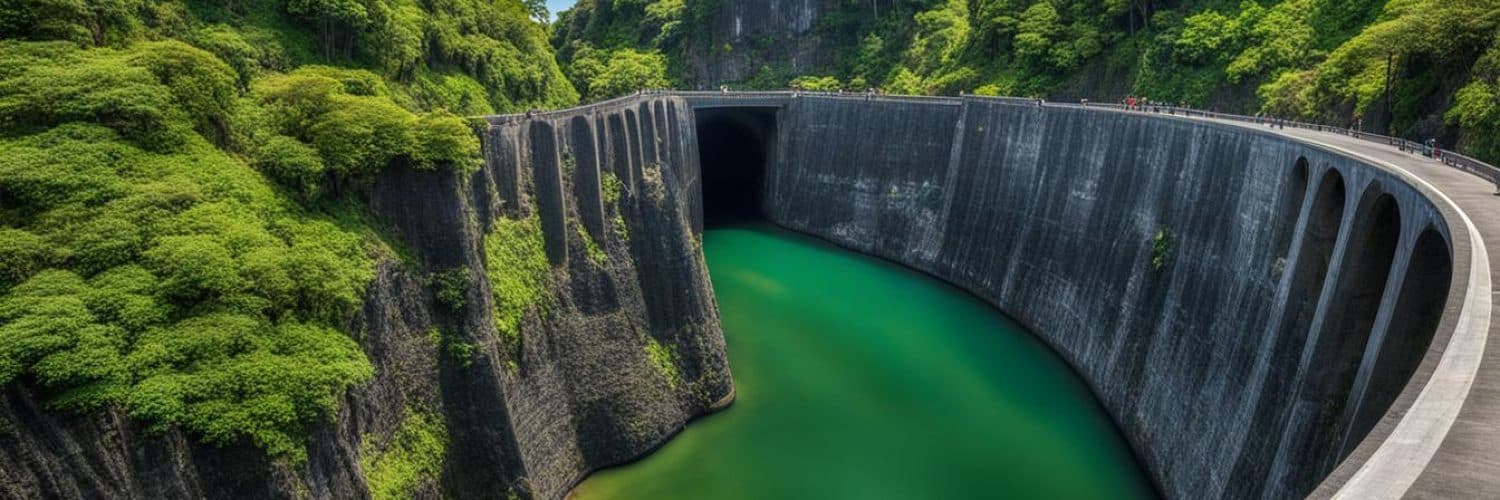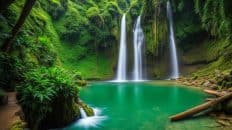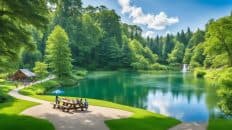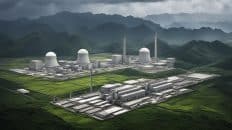Corregidor Island, located at the entrance to Manila Bay, is a captivating travel destination that invites you to immerse yourself in the rich tapestry of Filipino history and military heritage. This island in Cavite holds a significant place in the country’s past, with its historical landmarks and remnants of its tumultuous past attracting visitors from around the world.
From the moment you step foot on Corregidor Island, you will be transported back in time. This island has played a crucial role in various historical events, including the Spanish-American War and World War II. As you explore its shores and traverse its rugged terrains, you’ll uncover the stories of valor, sacrifice, and resilience that have shaped the course of Filipino history.
Key Takeaways:
- Corregidor Island in Cavite offers a unique blend of historical landmarks and military history.
- Visitors can experience the island’s rich Filipino history through guided tours and sightseeing.
- The island’s strategic location has made it a vital defense location throughout history.
- Corregidor Island is home to preserved ruins and important sites that pay tribute to the sacrifices made by soldiers.
- Immerse yourself in the island’s eerie tunnels and uncover the haunting presence of its past.
The Role of Corregidor Island in World War II
During World War II, Corregidor Island played a significant role as the temporary headquarters of the Philippine Government during the Japanese invasion of the Philippines in 1941. The American and Philippine troops stationed on the island fought courageously to defend it, utilizing the tunnels carved into the rock as ammunition storage and hospitals. However, due to lack of reinforcements, Corregidor was eventually surrendered to the Japanese in 1942. It was not until 1945 that American and Philippine forces regained control of the island, after enduring months of bombardment.
The strategic location of Corregidor Island in Manila Bay made it a crucial stronghold during World War II. It served as a key defensive position against the invading Japanese forces, allowing the American and Philippine troops to resist their advances and launch counterattacks. The island’s underground tunnels, which were originally constructed during the American occupation, became vital in defending against enemy assaults. These tunnels provided essential shelter, storage, and medical facilities, allowing the defenders to sustain their resistance.
Despite the fierce resistance, the defenders of Corregidor Island faced overwhelming odds. The lack of reinforcements, dwindling supplies, and constant bombardment from air, sea, and land forces ultimately forced the surrender of the island. The victorious Japanese forces took control of Corregidor in May 1942, marking a significant turning point in World War II in the Pacific.
For nearly three years, Corregidor Island remained under Japanese occupation, serving as a key strategic base for their operations in the Philippines. The island’s strategic location provided the Japanese with a vantage point to control the crucial Manila Bay and launch further offensives in the region. However, the American and Philippine forces never forgot about Corregidor and continued their efforts to liberate the island.
In 1945, after months of intense bombardment and fierce fighting, American and Philippine troops finally recaptured Corregidor Island. The successful operation to retake the island, known as Operation Topside, marked a significant victory and played a crucial role in the overall Pacific War campaign. The recapture of Corregidor was a symbolic triumph, signifying the determination and resilience of the Allied forces and marking the beginning of the end for Japanese control in the region.
| Key Events | Date |
|---|---|
| Japanese invasion of the Philippines | December 8, 1941 |
| Surrender of Corregidor to the Japanese | May 6, 1942 |
| American and Philippine forces retake Corregidor | February 16, 1945 |
The role of Corregidor Island in World War II stands as a testament to the bravery and sacrifice of all the soldiers who fought and defended this strategic stronghold. Today, the island serves as a living memorial, preserving the memory of the events that unfolded during the war and honoring the heroes who fought for freedom.
Corregidor Island Today: A Tourist Destination
Corregidor Island, once a strategic defense location, has now become a sought-after tourist destination. Visitors are captivated by the island’s historical sites and landmarks that provide a glimpse into its storied past. Several tour companies offer guided day tours to Corregidor Island, providing visitors with an immersive and educational experience.
Upon arrival, tourists have the opportunity to explore the well-preserved military installations, ruins, and significant sites that pay homage to the Filipino and American forces who bravely fought during World War II. These historical attractions allow visitors to gain a deeper understanding of the island’s rich history and the sacrifices made by those who defended it.
In addition to the historical landmarks, Corregidor Island also offers a range of recreational activities to cater to every traveler’s interests. South Beach, for example, provides a picturesque setting for swimming and basking in the sun, while adventurers can satisfy their thrill-seeking desires by zip-lining through the island’s lush tropical foliage.
Whether you’re a history enthusiast eager to explore the remnants of the past or a traveler seeking relaxation and adventure, Corregidor Island has something to offer. Let’s delve deeper into the tourist attractions and activities that make this island a must-visit destination.
| Tourist Attractions | Activities |
|---|---|
| Malinta Tunnel | Light and sound show, historical tour |
| Japanese Garden of Peace | Meditation, reflecting on history |
| Mile-long Barracks | Historical site, guided tour |
| Battery Hearn | Scenic viewpoints, photography |
| Filipino Heroes Memorial | Pay tribute, honor fallen soldiers |
| South Beach | Swimming, relaxation |
| Zip-lining | Adrenaline, adventure |
How to Get to Corregidor Island
To reach Corregidor Island, tourists can take advantage of the day tours offered by tour companies that include ferryboat transfers. The tours typically provide transportation to and from the island, guided tours, and meals. The journey to the island takes approximately an hour, and visitors have the option to rent ATVs, buses, or jeepneys for exploring the island. While day trips are common, there are accommodations available for those who wish to spend more time on the island.
The guided tours ensure a hassle-free experience, as visitors can simply sit back and enjoy the picturesque views during the ferryboat transfers. The knowledgeable tour guides provide valuable insights into the island’s history and landmarks, enriching the travel experience.
For those who prefer a more adventurous journey, renting an ATV, bus, or jeepney allows visitors to explore the island at their own pace. This option provides flexibility and the opportunity to uncover hidden gems and off-the-beaten-path attractions.
Whether opting for a guided tour or self-exploration, getting to Corregidor Island is a seamless process, with ferryboat transfers readily available for visitors to embark on their memorable journey.
| Transportation Options | Advantages |
|---|---|
| Ferryboat Transfers | |
| ATV, Bus, or Jeepney Rental |
|
Must-Visit Sites on Corregidor Island
Corregidor Island, located at the entrance to Manila Bay, is home to several must-visit sites that offer a fascinating glimpse into its history. From preserved landmarks to symbolic memorials, there is much to explore and discover on this historic island.
The Malinta Tunnel
The Malinta Tunnel is a standout attraction on Corregidor Island. Originally serving as a bomb shelter during World War II, this fascinating tunnel now hosts a captivating light and sound show that provides visitors with a deeper understanding of the island’s wartime experience. Step inside and be transported back in time as you learn about the challenges faced by soldiers and civilians during the war.
Japanese Garden of Peace
The Japanese Garden of Peace is a poignant site that symbolizes the reconciliation and friendship between the Filipino and Japanese people. It serves as a reminder of the importance of peace and unity, contrasting the history of conflict that the island once witnessed. Take a peaceful stroll through the garden and reflect on the enduring hope for harmony.
Mile-long Barracks
The Mile-long Barracks is a historic building that once housed American military personnel stationed on the island. Now in ruins, the barracks stand as a powerful testament to the island’s tumultuous past. Explore the remains and imagine the lives of those who lived and worked within these walls during wartime.
Battery Hearn
Battery Hearn is another significant landmark on Corregidor Island. This battery mount showcases the island’s military history and offers a panoramic view of Manila Bay. Take in the breathtaking scenery and appreciate the strategic importance of Corregidor Island during times of conflict.
Filipino Heroes Memorial
The Filipino Heroes Memorial is a tribute to the bravery and sacrifices of Filipino soldiers who fought during World War II. This monument stands as a solemn reminder of their unwavering courage and dedication. Pay your respects and learn more about the heroism displayed by these valiant individuals.
These are just a few of the must-visit sites on Corregidor Island that offer a unique blend of historical significance and cultural importance. Each landmark provides a different perspective on the island’s past, enriching your visit and deepening your appreciation for its historical heritage.
| Must-Visit Sites | Description |
|---|---|
| The Malinta Tunnel | A bomb shelter turned interactive light and sound show, providing insights into life during World War II. |
| Japanese Garden of Peace | A symbolic site representing peace and friendship between the Filipinos and the Japanese. |
| Mile-long Barracks | A historic building that once housed American military personnel, now in ruins, offering a glimpse into the island’s past. |
| Battery Hearn | A battery mount featuring breathtaking views of Manila Bay and highlighting Corregidor Island’s strategic significance. |
| Filipino Heroes Memorial | A tribute to the bravery and sacrifices of Filipino soldiers during World War II, honoring their heroism. |
Rich History and Natural Beauty of Corregidor Island
In addition to its historical significance, Corregidor Island is a treasure trove of natural beauty. The lush tropical island is enveloped in vibrant greenery, creating a serene and peaceful ambiance for visitors. The island’s natural landscape perfectly blends with the remnants of historical landmarks, such as the iconic lighthouse and intriguing ruins. Corregidor Island offers travelers a unique opportunity to immerse themselves in both rich history and breathtaking natural vistas.
“Corregidor Island is a testament to the harmonious coexistence of historical landmarks and natural splendor. It is an enchanting destination that captures the essence of Filipino culture and showcases the indomitable spirit of its people.” – Travel Enthusiast
Embedded within the island’s picturesque surroundings are historical relics that weave a tapestry of stories from the past. The harmonious blend of flora, fauna, and remnants of the past creates an atmosphere that ignites the imagination and awakens a sense of awe.
Tranquil Oasis Amidst History
Corregidor Island is blessed with an abundance of natural wonders that beckon explorers. The tranquil South Beach, with its pristine shores, offers a refuge for those seeking sun, sand, and serenity. Surrounded by crystal-clear waters, it provides an idyllic spot for swimming, snorkeling, or simply basking in the sun.
Exploring the Island’s Biodiversity
Beyond the shores, Corregidor Island boasts a diverse ecosystem that supports a wide array of plant and animal species. Guided nature walks allow visitors to discover the island’s unique biodiversity and witness its delicate balance of flora and fauna.
The island’s vibrant greenery provides a sanctuary for numerous bird species, making it a birdwatcher’s paradise. Visitors may catch a glimpse of the elusive Philippine scops owl or the colorful pygmy seahorse nestled among the thriving coral reefs just off the coast.
Preserving Corregidor’s Natural Heritage
Efforts are underway to preserve Corregidor Island’s natural heritage and sustain its ecological balance. The island’s pristine environment is safeguarded through responsible tourism practices that emphasize conservation and eco-friendly initiatives.
By promoting awareness of the island’s natural beauty, visitors can better appreciate the delicate ecosystem and contribute to its preservation. Corregidor Island serves as a testament to the harmonious coexistence of historical landmarks and natural wonders, exemplifying the need for sustainable travel destinations.
“The intertwining of history and nature on Corregidor Island creates an extraordinary travel experience. It is a testament to the resilience of nature and the enduring stories of the past.” – Nature Enthusiast
Corregidor Island proves that history and natural beauty can coexist harmoniously, inviting travelers to explore and appreciate the wonders of both. Whether wandering through the island’s lush landscapes or uncovering the stories etched on its historical landmarks, visitors are captivated by the intriguing fusion of past and present.
The Eerie Tunnels of Corregidor Island
One of the most intriguing aspects of Corregidor Island is its extensive underground tunnels. These tunnels served as storage for ammunition and hospitals during World War II, and they hold a haunting presence. Legend has it that the tunnels are haunted by the spirits of Japanese soldiers who took their own lives before the defeat. Whether or not you believe in the paranormal, the tunnels are a chilling reminder of the violence and strife that occurred during the war.
Explore the eerie tunnels of Corregidor Island, witnesses of its dark military history. These underground passages, once bustling with activity, now echo with the memories of the brave soldiers who fought and succumbed to the horrors of war. As you step into the dimly lit tunnels, you can almost feel the weight of history pressing upon you, experiencing firsthand the sense of confinement and claustrophobia that the soldiers endured. Venturing into the tunnels is an unnerving yet captivating experience, a chance to reflect on the sacrifices made and pay homage to the fallen.
Legends and Tales of the Eerie Tunnels
The eerie atmosphere of the tunnels has given rise to numerous stories and legends, passed down through generations. It is said that the restless spirits of Japanese soldiers still wander these underground passages, their presence felt in mysterious whispers and unexplained footsteps. Some visitors have claimed to have heard ghostly cries or seen apparitions, adding to the enigmatic aura of the tunnels.
While the eerie tunnels may unsettle some, they offer a unique glimpse into the past and provide an opportunity for contemplation. They serve as a solemn reminder of the immense human toll of war and the lasting scars it leaves behind, both physical and spiritual.
“The tunnels of Corregidor Island bear witness to the bravery and sacrifice of those who fought to defend our freedom. They remind us of the horrors of war and the enduring spirit of resilience.” – General Emilio Aguinaldo
Guided Tours of the Tunnels
To fully appreciate the eerie tunnels of Corregidor Island, it is recommended to join a guided tour led by knowledgeable local guides. These experts will provide insights into the historical significance of the tunnels and share captivating stories about the events that took place within their dimly lit confines. As you traverse the labyrinthine network of passages, you will gain a deeper understanding of the island’s military history and the courage of those who fought here.
During the guided tour, you will also have the opportunity to explore the various sections of the tunnels, including the hospital areas, ammunition storage rooms, and officer quarters. Each section tells a different story, contributing to the overall eerie atmosphere that permeates the tunnels.
Visiting the Eerie Tunnels
When planning your visit to Corregidor Island, make sure to allocate sufficient time to explore the eerie tunnels. Take a moment to immerse yourself in the history and reflect upon the sacrifices made by those who came before us. Whether you are a history enthusiast, a thrill-seeker, or simply curious about the island’s past, the eerie tunnels of Corregidor Island are a must-visit destination that will leave a lasting impression.
Future of Corregidor Island Tourism
Corregidor Island continues to attract tourists who are interested in its historical significance and natural beauty. As the popularity of the island as a tourist destination grows, there are ongoing efforts to further develop and enhance the tourism experience. These efforts include improving tourism infrastructure, introducing new activities and attractions, and preserving the island’s historical sites. With proper planning and sustainable practices, Corregidor Island has the potential to become a premier travel destination in the Philippines.
Improving Tourism Infrastructure
The future development of Corregidor Island’s tourism relies heavily on improving and expanding its infrastructure. This includes upgrading the ferryboat transfers for smoother and more efficient transportation to and from the island, as well as enhancing the facilities available to accommodate the growing number of visitors. Upgrading the existing accommodations and building new ones will ensure a comfortable stay for tourists who wish to spend more time exploring the island.
Introducing New Activities and Attractions
To enhance the tourism experience and attract a wider range of visitors, new activities and attractions can be introduced on Corregidor Island. For adventure enthusiasts, the island can offer activities such as hiking trails, kayaking, and snorkeling opportunities to explore the surrounding waters. Additionally, the island can also host cultural events, art exhibits, and historical reenactments to engage visitors and provide them with a deeper understanding of the island’s heritage and culture.
Preserving Historical Sites
Preserving Corregidor Island’s historical sites is crucial for maintaining its authenticity and attracting tourists interested in its rich history. Efforts should be made to protect the remaining ruins, fortifications, and artifacts that serve as tangible reminders of the island’s past. This can be achieved through proper maintenance, restoration projects, and implementing guidelines to ensure responsible tourism.
“Corregidor Island has a unique historical significance that appeals to tourists from all over the world. By prioritizing the preservation of its historical sites and introducing new attractions and activities, we can guarantee an immersive and unforgettable experience for anyone who visits.” – [Name], Tourism Director
The future development of Corregidor Island’s tourism holds great promise. With a focus on improving infrastructure, introducing new activities, and preserving its historical sites, the island can position itself as a premier travel destination in the Philippines. A harmonious blend of history, natural beauty, and cultural experiences awaits those who choose to explore this captivating island.
| Benefits of Future Development | Enhanced tourism experience | Increased visitor satisfaction | Boost in local economy |
|---|---|---|---|
| Improved infrastructure for smoother travel | New and exciting activities for tourists | Preservation of historical sites | Job creation in the tourism industry |
| Attracts a wider range of tourists | Cultural events and exhibits | Sustainable tourism practices | Opportunities for local businesses |
Conclusion
Corregidor Island, located in Cavite, is a mesmerizing travel destination that offers a perfect blend of historical landmarks, military history, and natural beauty. This picturesque island holds a significant place in Filipino history, with its role during World War II leaving an indelible mark on its landscape.
Visitors to Corregidor Island can immerse themselves in the rich military history by exploring the preserved ruins and important sites that pay homage to the sacrifices made by soldiers. The island’s historical landmarks, such as the Malinta Tunnel and the Filipino Heroes Memorial, provide a profound insight into the resilience and courage of those who fought during the war.
But Corregidor Island isn’t just about its historical significance. It also boasts breathtaking natural beauty, with lush greenery and stunning vistas that create a serene and peaceful atmosphere. Whether you’re exploring the eerie tunnels or simply enjoying the island’s natural landscapes, Corregidor Island offers an unforgettable experience for all who visit.
As tourism continues to thrive on Corregidor Island, efforts are being made to enhance the visitor experience and preserve its rich history. With ongoing developments and improvements, this travel destination is poised to become one of the premier destinations in the Philippines for history enthusiasts and nature lovers alike.
FAQ
What is the historical significance of Corregidor Island?
What role did Corregidor Island play in World War II?
Corregidor Island served as the temporary headquarters of the Philippine government during the Japanese invasion in 1941. American and Philippine troops defended the island, utilizing tunnels for storage and hospitals. However, Corregidor was eventually surrendered to the Japanese and was only retaken by American and Philippine forces in 1945.
Is Corregidor Island open to tourists?
Yes, Corregidor Island is now a popular tourist destination. Several tour companies offer guided day tours to the island, which include ferryboat transfers, guided tours, and meals. Visitors can explore the preserved military installations, ruins, and important sites that pay tribute to the sacrifices made during World War II.
How do I get to Corregidor Island?
To reach Corregidor Island, you can take advantage of the day tours offered by tour companies that include ferryboat transfers. The journey to the island takes approximately an hour, and visitors have the option to rent ATVs, buses, or jeepneys for exploring the island. Accommodations are also available for those who wish to spend more time on the island.
What are the must-visit sites on Corregidor Island?
Corregidor Island boasts several must-visit sites, including the Malinta Tunnel, which served as a bomb shelter during World War II and now hosts a light and sound show. The Japanese Garden of Peace, the Mile-long Barracks, Battery Hearn, and the Filipino Heroes Memorial are also significant landmarks that offer a deeper understanding of the island’s history.
What is the natural beauty of Corregidor Island?
In addition to its historical significance, Corregidor Island is known for its lush greenery and serene atmosphere. The island’s natural landscape seamlessly blends with the remnants of the historical landmarks, such as the lighthouse and ruins. Visitors can enjoy the stunning natural beauty while immersing themselves in the island’s rich history.
Are the tunnels on Corregidor Island haunted?
Legend has it that the tunnels on Corregidor Island are haunted by the spirits of Japanese soldiers who took their own lives before the defeat. Whether you believe in the paranormal or not, the tunnels serve as a chilling reminder of the violence and strife that occurred during World War II.
What is the future of tourism on Corregidor Island?
As tourism on Corregidor Island continues to thrive, efforts are being made to enhance the visitor experience and preserve the island’s rich history. This includes improving tourism infrastructure, introducing new activities and attractions, and preserving the island’s historical sites. Corregidor Island has the potential to become a premier travel destination in the Philippines.


















Add comment